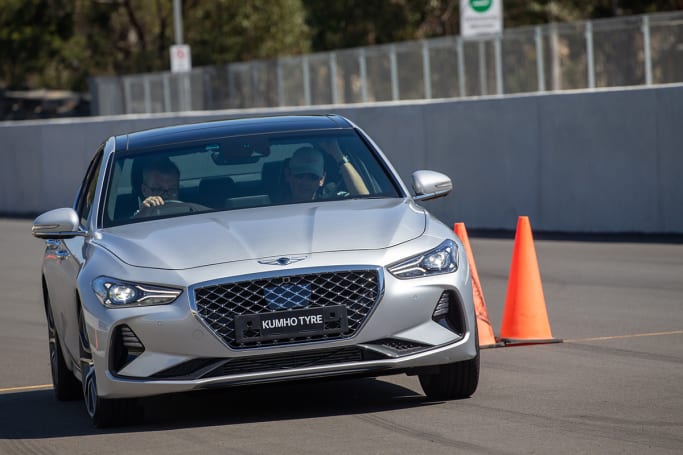
Kumho tyre review: PA 51
- Kia Stinger
- Genesis G70
- Kia Stinger Reviews
- Genesis G70 Reviews
- GENESIS Reviews
- Kia Reviews
- GENESIS
- Kia
- Tyres
- Safety
- Race track

Tyres are kind of a big deal. They aren't nearly as flashy or as easy on the eye as the cars that wear them, but they're a big industry, nonetheless.
Did you know, for example, that Kumho is apparently Australia's number-three tyre company? Did you also know that it's the number one tyre marker in Korea, or even that Korea is the country it hails from?

To be fair, most people wouldn't know those things. But then, a lot of people also wouldn't be able to tell you what brand of tyres are on their car right now, or exactly how much it would cost to replace them. And that's because, even though they are hugely vital in literally keeping us on the road, and thus safe and alive, tyres are just not something a lot of people give much consideration to.
If you've purchased an even mildly sporty car in the last year or two there's a good chance that it will be wearing some premium rubber; think Continental ContiSportContact series, Bridgestone Potenzas, or Pirelli Anythings (they're all expensive, regardless of the logo).
I hate to be the harbinger of bad news, but that means your next set of tyres is going to cost a lot. Somewhere between $2500 and $3500, depending on the size and relative obscurity of your wheels. Hell, I even drove a $23,000 Kia Rio fitted from the factory with $1000 worth of Continental tyres on it.

If that's managed to get your attention, you might well be interested in find out about a new set of rubber called Kumho Ecsta PA51s.
This new range of tyres from the Korean manufacturer are explicitly targeted at recent owners of cars like the BMW 3 Series, Audi A4 – A6, Benz C- and E-Class, as well as Korean challenger performance offerings, like the Genesis G70 and Kia Stinger (which we've conveniently driven here), to combat what Kumho calls "tyre shock" when it comes to the price of a replacement set.
The PA51 is an all-season tyre in Kumho's five-tyre performance range. That means it's not angled toward track use, with a limited-life soft compound, but more to the everyday driver who needs a long-wearing compound, but could also be track-curious.

To that end it's been engineered not only with an asymmetrical tread and rigid outside shoulder, much like its performance competitors, but also with chunks of tread designed to deal with rain and snow, for more everyday scenarios. These chunks have also been designed to aid with noise cancellation, to make for a quiet and comfortable ride.
The PA51 can be had across many widths on wheels that range from 16 to 20-inches, and Kumho pitches its prices at "about $1500" for a set like the ones on our test Stinger.
This means they undercut rivals like the Bridgestone Potenza (up to $2,480 a set) by a decent margin. Kumho also offers a 'Road Hazard' warranty for most of its non-eco tyre range. The warranty covers you for the first 25 per cent of tread life or 12 months and grants owners a free replacement tyre if it suffers irreparable damage (not including vandalism).

These help Kumho's aim to be "the Hyundai/Kia of tyres" which – as the brand clarifies – means offering comparable performance to Japanese and European rivals at more competitive prices.
Strapped to a very orange Kia Stinger, we were offered the opportunity to subject the PA51's to a series of tests – both in the dry and in the wet. These included a full-stop brake test (with an ambitiously small target stop area), a slalom and a collection of both wet and dry corners.
All tests certainly gave the impression of a performance tyre – easily a cut above any "eco" tyre I've driven on, although without the ability to test it against competitors under the same conditions it's impossible to make a determination on where it sits in its category.

We did, however, get a chance to test the PA51s against the next tyre up in Kumho's range, the PS71 – a softer, more performance-oriented setup.
Again, comparisons were difficult to make – as the PS71s were fitted to a Genesis G70. It's the same chassis as the Stinger, sure, but with a softer and slightly more luxurious suspension tune. The G70, for example, would tilt in the corners, and seemingly didn't do as well in the stop-tests, as its softer front-end would nosedive, bringing the gravitational effect with it. It's worth noting, however, that both cars stopped in an impressively short distance.
Also remarkable was how relatively difficult it was to make even the V6 stinger break traction, and how quickly it regained it once a slide had begun.
Throughout the day, despite many drivers' best efforts, the track was an impressively quiet place to be, with neither set screaming out in particularly high-pitched pain, even in the tightest corners.

Verdict
Tyres like these are an essential part of the safety equation on your vehicle – you can have all the active-safety gear you want, but on cheap and worn-out rubber there's only so much stability control will do for you.
While many enthusiasts will already have their favourite performance-tyre brand – casual punters with performance vehicles looking to trim down their running costs ought to at least give these value-focused Kumhos a look.






